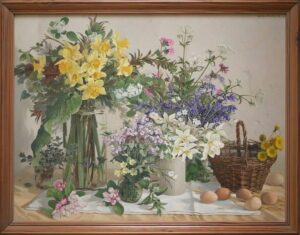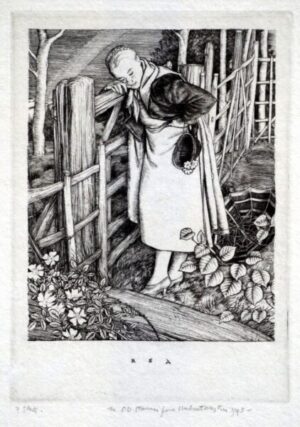Description
Close examination of two other examples in museum collections shows our print has been etched onto a separate plate. Apart from the image being in reverse some parts of the composition have been altered, such as the yellow flower on the left side of the box. All the etched lines are different, and the publisher’s name and date have not been included in with the title. To compare see the attached photo of the print in the collection of the BM.
Collections: British Museum: Number; 1868,0808.7403 and the Royal Museums Greenwich: Object ID; PAG8562 – Both these etchings have been printed by W. Holland, 1805.
Condition: Trimmed to the plate, a missing piece of paper has been infilled and coloured to match the surrounding area (centre right). The print has been cleaned and consolidated by lining onto archival backing paper. All work has been carried out by an accredited paper conservator.
William Holland (1757-1815) had a successful business, his print list included works by; Frederick George Byron, George Murgatroyd Woodward, John Nixon, James Gillray and Thomas Rowlandson. A radical, he was prosecuted in 1793 on charges of seditious libel for selling a copy of Thomas Paine’s Letter Addressed to the Addressers and was incarcerated in Newgate Prison.
Addresses:
66 Drury Lane (by July 1783 – end of 1786)
50 Oxford Street, London (end 1786- end 1802)
11 Cockspur Street, opposite Pall Mall, London (end 1802-15)
As one of Britain’s greatest heroes, Admiral Lord Nelson’s funeral was among the grandest state occasions, lasting over five days. His body was returned to England from Trafalgar on board HMS Victory, and he was buried at St Paul’s Cathedral in a coffin made from the mast of the French ship, L’Orient, destroyed at the Battle of the Nile, seven years earlier. Here, a disgruntled sailor, Jack, has constructed a monument to Nelson in his garden. It resembles the makeshift altars of piles of drums used in the drumshead ceremony, when a soldier was interred at sea or on the field of battle. However, Jack has replaced the drums with two barrels (‘cags’) of grog, a mixture of rum and water. A banner at his feet notes that sailors were to pay an entrance fee to view Nelson’s tomb, to which he objects, “I’ll be no Towpenny Customer at St Paul’s! This shall be poor Jack’s Monument, in his little Garden, to his Noble Companion.”
A sailor stands with folded arms, looking up at the monument he has erected in his garden. At his feet is a scroll: ‘Every person who wishes to see the Monuments in St Paul’s must pay Twopence!! Sailors should have a free admission.’ A large sea-chest is placed under a weeping willow; on it is its key labelled ‘Jack Junk Victory’. Two casks stand on the chest; two crossed cutlasses are poised symmetrically on the casks; their hilts support Nelson’s cocked hat, with the jewelled aigrette or chelengk (see BMSat 9269). A heart rests on the apex of the hat. The hat and cutlasses are framed by black drapery which is looped round the heart and over two branches (l. and r.) of the tree, hanging vertically. On the chest is inscribed: ‘And a third part of their ships were destroyed, Revelations Chap, 8, Verse, 9, [of 33 ships of the line, 11 only regained Cadiz after Trafalgar]’. Behind are shrubs and sunflowers. The sailor is stout and middle-aged; he wears short jacket, striped trousers, round hat, and buckled shoes. He looks up with stern and pugnacious melancholy. Above his head: “I’ll be no Towpenny Customer at St Paul’s! This shall be poor Jack’s Monument, in his little Garden, to his Noble Companion – first of all is my Sea Chest, in memory of the many Voyages I have had with his Honor – on it I have chalk’d a Text from Scripture suitable to the occasion – then comes two Cags of Grog in memory of his noble Spirit – then two Hangers in memory of his gallant bravery – his uniform Hat, which reminds me of the Nile, Copenhagen, and, Trafalgar, – and above all is the figure of an Englishman’s Heart, hung with black Crape.



